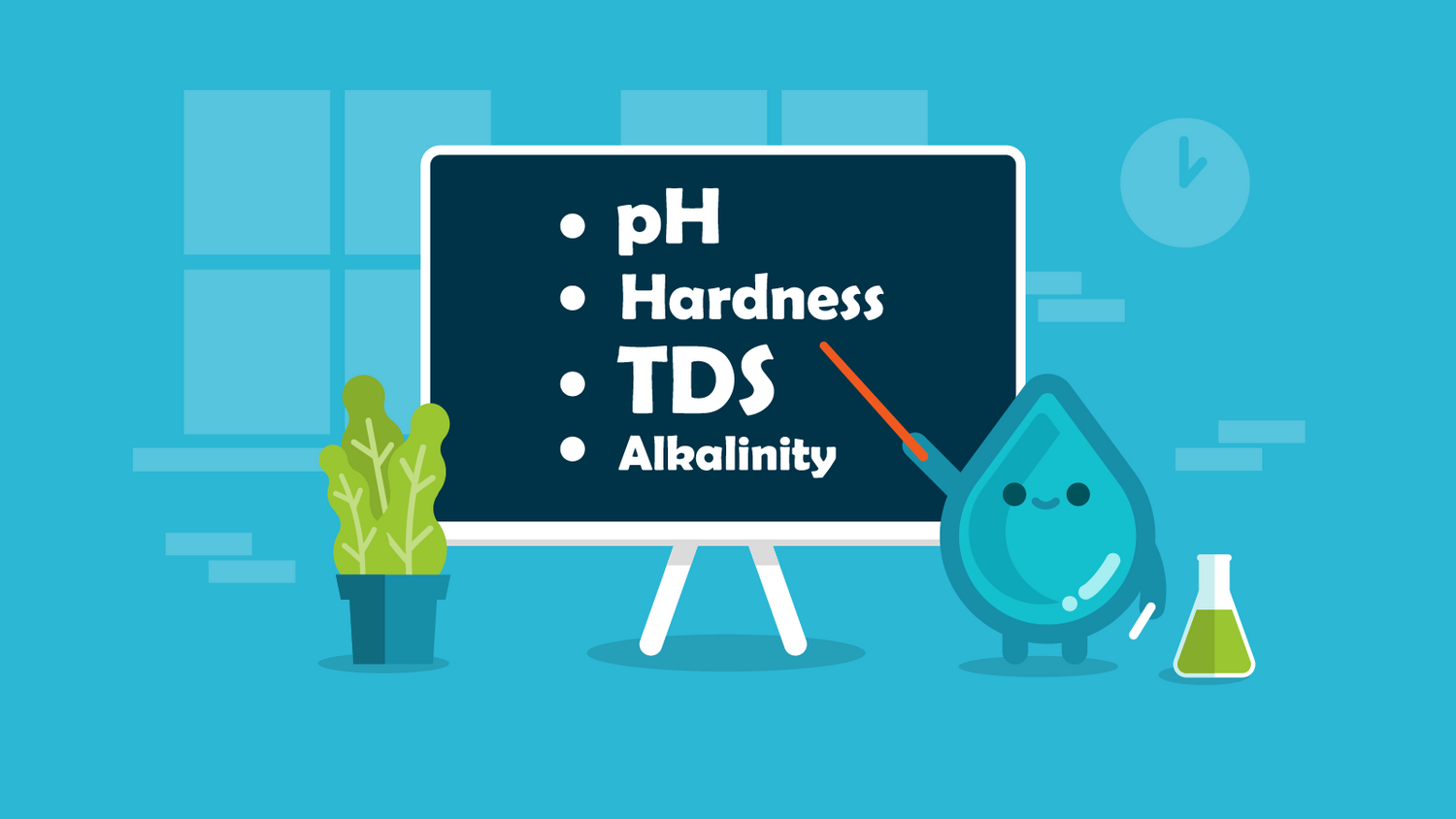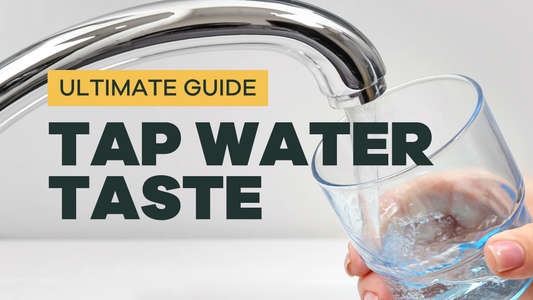
General Chemistry of Water
Our blog is written by real experts— not AI. Each guide is carefully reviewed and updated based on the latest research. Plus, with no affiliate links, you can count on unbiased insights you can trust.
There are many technical terms surrounding the general properties of your drinking water, but this shouldn’t stop you from knowing your water’s fundamental chemistry. Rather than leaving you scratching your head (and searching the internet for hours), we’ve assembled this handy guide to help you understand what some of the most important and fundamental water properties mean.
We think everyone who drinks water (i.e., everyone!) should know about these main water properties and why they matter.
We’ll take a look at the following water properties: hardness, total dissolved solids (TDS), pH, and alkalinity. Read on to find out why each is important, what they mean for your water quality and health, general ranges, and what to do about them.
Table of Contents:
- What Is Hard Water?
- Total Dissolved Solids (TDS)?
- pH?
- Alkalinity?
- What Is Your Water's General Chemistry?
What Is Hard Water?
Water is typically categorized as “hard” if it contains high levels of dissolved and positively charged minerals like calcium and magnesium.
85% of U.S. drinking water has some degree of hardness. While it is not a health hazard, it can be a bother to your pipes, faucets, and other water fixtures
Water that lacks these hard minerals is called soft water.
You’ll most likely hear about hard water and a water softener in the same context. This is because a water softener is a treatment device or water conditioning system that removes hard minerals from water and usually replaces those minerals with something less problematic. Water that has been treated or conditioned by a water softener tastes differently than hard water; it also leaves less of a residue on fixtures.
Why Does Water Hardness Matter?
Hard water is likely to leave mineral deposits on everything it touches. This means that hard water can cause problems in a home or business. Hard water can:
- Clog pipes through the formation of mineral deposits called scale.
- Leave marks on sinks, baths, and toilets.
- Prevent your soap from lathering or forming bubbles.
- Cause expensive malfunctions and damage to water-related equipment like heaters, kettles, and cooling towers.
Hardness is not inherently bad or dangerous, however. A small amount of water hardness is actually good for your tap water because hard elements like magnesium and calcium will naturally coat the inside surfaces of your pipes and protect them from corrosion (which will reduce the likelihood of metals leaching from plumbing into your drinking water).
Scale, Corrosion, and Plumbing
Is It Safe To Drink Hard Water?
Hard water can be beneficial. Often when we discuss water quality and health, we only think about the negative impacts. But the National Research Council states that hard water generally contributes (between 5-20%) toward total calcium and magnesium dietary needs. While there is some evidence linking water hardness to other health conditions, it’s not yet fully clear what (if any) negative health impacts there may be.
Water hardness above 400 PPM however, may very well merit treatment for the sake of avoiding potential health impacts. Even though there is no health concern yet fully endorsed by the scientific community, hardness at a high enough level should be reduced in order to avoid potential unwanted impacts to skin and hair.
Some water softeners use “ion exchange” technology, where calcium and magnesium (water hardness ions both) are exchanged for sodium ions in your water.
It’s unlikely that the extra sodium in your water will cause a health problem, but if you have high blood pressure, you can avoid worrying about the added salt content by choosing “salt-free water softeners” (they tend to use potassium chloride ions).
What Level of Water Hardness Is Acceptable?
While there are different subjective interpretations of hard and soft water, here is a general guide for classifying your water’s hardness measurement.

In order to find an equivalent unit to measure all ions that make up water hardness, engineers measure hardness as parts per million (PPM) of calcium carbonate because it is easy to measure and one of the primary sources of water hardness.
You might see that water hardness is measured with varying units:
- Parts per millions (PPM) of calcium carbonate (CaCO3)
- Milligrams per liter (mg/L) of calcium carbonate
- Grains per gallon (GPG)
We know that all these units can get confusing, here are some useful ways to convert from one unit type to another:
1 Grain = 17.1 mg/L of CaCO3
1 mg/L of CaCO3 = 1 PPM of CaCO3
What Can I Do About Water Hardness?
If you want to avoid hard water for any reason, there are two main water softening options you can consider investing in:
- Water softeners that use salt-based ion exchange technology
- Water softeners that use non-salt-based technology (like potassium chloride ions)
- Reverse osmosis (RO) treatment systems*
*Note: You’ll need to maintain your RO often if your water hardness is high and this can be expensive.
On the other hand, you may even need to add some hardness to your water if your water is too soft. Doing so means adding minerals like calcium or magnesium back into your water with a special remineralization filter. Having some hardness in your water is good for your pipes because it can protect them from the corrosive effects of overly soft water.
Because water hardness usually affects the entirety of a water system (pipes, faucets, showers, pumps, other equipment), water softeners are generally only installed at the facility or whole-home level. You won’t often install a softener and just one tap, rather you’ll find most products are designed for the full home or building. These systems are called point-of-entry (POE) (as opposed to point-of-use, or POU).
Point-of-entry vs. Point-of-use Water Treatment Systems
What Is TDS in Water?
Total dissolved solids (TDS) is a measure of all dissolved compounds in your water, primarily composed of benign or beneficial minerals. While these “dissolved solids" may refer to any substance you can’t see in your water, the term total dissolved solids (TDS) typically refers to these dissolved inorganic salts:
- Calcium
- Magnesium
- Potassium
- Sodium
- Bicarbonates
- Chlorides
- Sulfates
- Plus small quantities of dissolved organic matter.
Ultimately, a measure of total dissolved solids (TDS) is considered to be the sum of all inorganic and organic substances in the water.

In the United States, elevated TDS in water is often attributed to natural environmental features such as mineral springs, salt deposit, and seawater intrusions. However, other sources of TDS in drinking water may come from:
- Sewage
- Urban or agricultural runoff
- Industrial wastewater
- Chemicals used water treatment processes
- Salts for de-icing roadways
Why Do Total Dissolved Solids Matter?
High TDS concentrations in your water are likely to cause aesthetic issues rather than health issues. Due to these possible effects, TDS is only listed as a Secondary Drinking Water Standard by the EPA—which means that they are governed by a non-enforceable guideline (rather than a mandatory standard).
High TDS levels may result in:
- An unpleasant taste (especially bitter or salty)
- An unpleasant appearance
- A film or precipitate on fixtures
Low TDS levels may result in:
- Corrosion of fixtures or pipes
- Reduced water filter efficiency
What Is a Safe Level of TDS?
There is no reliable data on the health effects of total dissolved solids, though elevated levels of some of the specific ions can cause negative health outcomes. This means that you need to look at the concentrations of individual compounds in your water to determine its safety and not the TDS. Extremely high TDS levels can indicate that potentially harmful contaminants (such a manganese, arsenic, or iron) are present in your water.
The primary impact of high TDS is an undesirable taste, as well as other aesthetic and operation issues like high hardness and potential for staining. The TDS of typical drinking water is anywhere from 50-200 PPM (parts per million). The EPA has set a secondary MCL of 500 PPM TDS to control for potential aesthetic and operational issues: salty taste, colored water, staining, hardness and deposits but this is not health-related.
What Is the Acceptable TDS Level in Drinking Water?

What Can I Do About High TDS in My Tap Water?
The best way to lower TDS in your tap water is to invest in a reverse osmosis water filter. Most RO systems will remove at least 95% of the TDS in your water.
What Is pH?
pH is a measure of a solution's acidity or basicity (sometimes referred to as alkalinity.) More specifically, pH measures the relative amount of free hydrogen and hydroxyl ions in the water. The pH scale ranges from 0 (acidic) to 14 (basic or alkaline). A pH of 7.0 is neutral. Water with more free hydrogen ions is acidic, while water with more free hydroxyl ions is basic.
Most tap water should fall in the range of 6 - 8.5. It’s important to note that the pH scale is logarithmic. This means each step on the scale corresponds to a ten-fold change in acidity. For example, water with a pH of four is ten times more acidic than water with a pH of five.
Why Does the pH of Water Matter?
Shifts in tap water pH can be caused by many different types of chemicals. This makes pH a crucial indicator of chemical changes and health of your drinking water.
Water with high pH may cause:
- Bitter taste
- Mineral deposits on pipes, faucets, and appliances
- Reduced effectiveness of chlorine disinfection
- Altered speciation of organic and inorganic compounds in your water
- Increased corrosivity
Water with low pH may cause:
- Increased corrosivity
- Altered speciation of organic and inorganic compounds in your water
- General increase in the solubility of metals
Does the pH of Water Make a Health Difference?
Typically, pH will not directly affect your health. However, the U.S. EPA, classifies pH as a Secondary Drinking Water Standard and recommends a pH between 6.5 and 8.5 for drinking water. If your water pH is outside of these limits then there is a stronger likelihood for pipes and fixtures to corrode and leach metals into your drinking water.
Low pH levels (below 5) can have seriously harmful health effects on local wildlife like fish and pets.
You may have also seen mentions of high pH water (also known as “alkaline water”) and its touted health effects. This viral “health” trend has gained attention in recent years as one of the most popular “functional water” fads, but current scientific literature fails to back up the claims of high pH water's superior health benefits.
What Is the Ideal pH of Drinking Water?

Also, maintaining a pH level within the EPA's recommended range ensures that your water is less likely to damage your plumbing system (and therefore less likely to leach harmful compounds). Water with pH values outside of 6.5 and 8.5 is not necessarily harmful on its own, however. In fact, carbonated water often has low pH values—even pHs below 4.
Drinking water with low pH as your main source of hydration could potentially impact your teeth over the long term, but there are no guidelines regarding this potential issue.
Can I Change the pH of My Water?
If your tap water pH is too low (below 6) you may consider any one of several known treatment solutions in order to raise the pH of your drinking water.
- Installing a water softener to add alkali-rich compounds into your water
- Installing a neutralizing filter to raise your water to near pH 7
- Installing a sodium hydroxide injection feed pump
- Adding lemons or baking soda to your glass of water (temporary fix)
If your tap water pH is too high (above 8.5) and you taste a chalky bitterness in your water, then you may consider lowering your pH by installing an acid injection system.
What Is Alkalinity?
Alkalinity is a buffer for your water’s pH. This means it is a measure of your water’s ability to resist changes in pH level. Alkalinity “does this” by neutralizing weak acids that may enter your water on the way to your tap.
Alkalinity in tap water is normally expressed as the sum of concentrations of bicarbonate, carbonate, hydroxide, and some phosphates and silicates.
The alkalinity in your water usually originates from limestone-like deposits that dissolved into your water source (e.g. well, aquifer, etc.)
Why Does Alkalinity Matter?
Alkalinity mitigates changes to your water’s pH. This makes alkalinity important because swings in pH often lead to many other noticeable and un-noticeable changes in your overall water quality. Such changes may very well relate to your water’s health and maintenance concerns. In general, you don’t want your water pH swinging up and down or else your water quality and water health will be hard to predict.
While lower alkalinity waters can be more corrosive (i.e. low alkalinity allows weak acids to enter the water supply and they are more likely to lower the pH), higher alkalinity waters are more likely to form scale (i.e. mineral deposits) on your pipes and other fixtures which makes your plumbing system less effective.
Alkalinity is not detrimental to humans. In fact, alkalinity can often have a positive impact on your pipes and water distribution system.
When combined with hardness, moderately alkaline water can form a layer of calcium or magnesium carbonate that can inhibit or reduce corrosion of metal pipes.
Note: Most water distributors try to make your water slightly alkaline in order to strike a balance between coating the pipes with a safe level of calcium carbonate, and not so much so that your pipes are at risk of damage or scale build-up.
Is Alkaline Water “Healthier”?
There is currently no health standard for alkalinity in drinking water.
While many bottled water companies have released alkaline water products in the past several years, the claims that alkaline water provides health benefits are largely unproven by the general science and health communities.
Alkaline water companies may claim that alkaline water slows aging, increases energy levels, helps with fertility, and helps you regulate your body’s pH level to prevent chronic diseases like cancer, but none of these claims have been proven.
What Is the Ideal Alkalinity of Drinking Water?

In general, you want your water’s alkalinity measurement to fall within 75% - 100% of your water’s hardness measurement (assuming both are measured as calcium carbonate, CaCO3 ). This is because, when reported in PPM (or mg/L) of calcium carbonate, alkalinity and hardness are nearly equal in concentration (because they generally come from the same minerals).
Note: Do not confuse “alkaline water” (high pH water with more OH- ions than H+ ions), with water “alkalinity” (water’s ability to neutralize acid and keep pH stable.)
What Can I Do About My Water’s Alkalinity?
Because a broad range of alkalinity in drinking water is considered acceptable, it is not often that folks need to alter their natural water alkalinity. A low level of alkalinity is desirable in tap water because it serves as a buffer that prevents large swings in pH.
If there is not enough alkalinity in your water (perhaps because of a reverse osmosis treatment machine) then you may try the following approaches to raise your alkalinity (and pH):
- Add a remineralization filter to add minerals back into your water
- Install a water distiller which will remove acids in the water
- Install a water ionizer to separate acidic and basic water
How Do You Learn About Your Water’s General Chemistry?
The first step is to test your water. Each of the general properties of water explained above have various impacts on your water quality—from taste or odor effects to more troubling changes like the increased likelihood of metals leaching into your water supply.
Using a certified laboratory to test your water will provide high-precision results that will ensure that your results are accurate and reliable.
Sources and References
▾The Drinking Water Taste Guide
What's the White Residue on My Fixtures?
Heavy Metals Everyone Should Test For
POE Versus POU Water Treatment
Water Q&A: Why is water the "universal solvent"?
Total Dissolved Solids Drinking Water Quality
Secondary Drinking Water Standards: Guidance for Nuisance Chemicals | US EPA
Chlorine and Chloramine as Water Disinfectants










